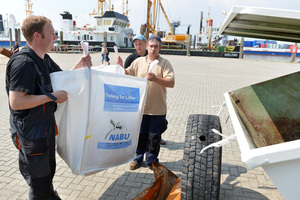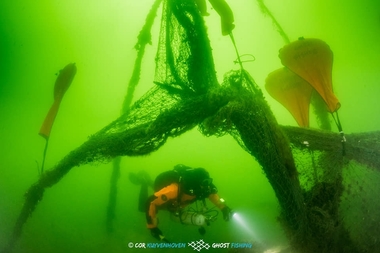“Fishing for Litter” – Sorting Analysis and
Material Testing of Plastic Waste from the Sea
Every year, more and more waste ends up in our seas, with a devastating impact on marine flora and fauna. Working together with fishermen on the North and Baltic Seas, NABU, Germany’s Nature and Biodiversity Conservation Union, launched the “Fishing for Litter” projecting 2011. Main objective to the project is retrieval of marine litter cached by chance during ordinary fishing and environmentally sound disposal onshore. But what happens then with the waste from the sea? In a downstream step, the waste is analyzed at Magdeburg-Stendal University of Applied Sciences. With dedicated processing, should path the way to sustainable recycling is opened up.
Literatur/Literature
[1] K. Remiorz (2017): Bild Fischernetze; Hochschule Magdeburg-Stendal
[2] Jambeck, Jenna R./Geyer, Roland/Wilcox, Chris et al. (2015): Plastic Waste Inputs from Land into the Ocean. In: Science 347/ 2015, S. 768-771
[3] Umweltbundesamt: „Herkunft mariner Abfälle“ (2013): unter: www.umweltbundesamt.de/sites/
default/files/medien/419/dokument/herkunft_mariner_abfaelle.pdf (abgerufen am 12.07.2016)
[4] NABU e.V.: „Fishing for Litter – Gemeinam für eine saubere Nord- und Ostsee“ unter: www.fishing-forlitter.de (abgerufen am 12.06.2017)
[5] BLMP: „Die MSLR – eine Chance für die europäischen Meere“ unter http://www.meeresschutz.info (abgerufen am 12.06.2017)
[6] Hahn M. (2016) Sortierung und werkstoffliche Prüfung von Netz- und Tauresten aus dem
Projekt Fishing for Litter. Masterarbeit Hochschule Magdeburg-Stendal
[7] Tietze R. (2014) Untersuchung der Qualität von Kunststoffabfällen aus dem Meer und deren
Verwertungsmöglichkeiten. Masterarbeit Hochschule Magdeburg-Stendal
[8] Deutsches Institut für Normung e.V. DIN EN ISO 11357-1. Kunststoffe – Dynamische Differenz-Thermoanalyse (DSC) – Teil 1: Allgemeine Grundlage
[9] Deutsches Institut für Normung e.V. DIN EN ISO 179. Kunststoffe – Bestimmung der CharpySchlageigenschaften – Teil 1: Nicht instrumentierte Schlagzähigkeitsprüfung
[10] Deutsches Institut für Normung e.V. DIN EN ISO 1133. Kunststoffe – Bestimmung der Schmelze-Massefließrate (MFR) und der Schmelze-Volumenfließrate (MVR) von Thermoplasten – Teil 1:Allgemeines Prüfverfahren
















